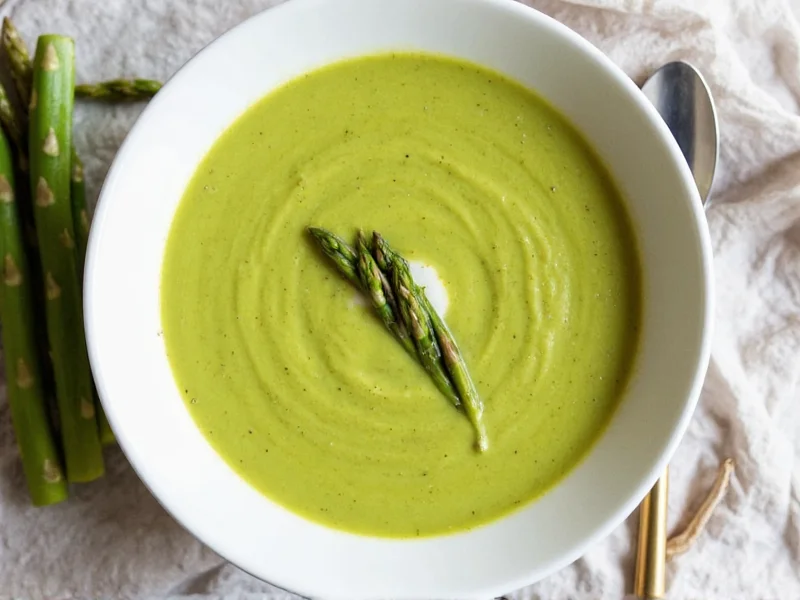Creating exceptional cream of asparagus soup requires understanding the delicate balance between preserving asparagus's vibrant flavor and achieving luxurious texture. This guide reveals professional techniques for making restaurant-quality soup at home, including how to prevent discoloration, enhance natural sweetness, and create variations for different dietary needs. Whether you're using thick asparagus spears from your garden or slender supermarket stalks, these methods ensure perfect results every time.
The Origins of Asparagus Soup
Asparagus has been celebrated in European cuisine since Roman times, but cream of asparagus soup as we know it emerged from French culinary tradition in the 19th century. French chefs perfected the technique of puréeing cooked asparagus with velouté sauce, creating the smooth texture that defines the dish. The addition of cream became standard in the early 20th century, transforming it into the elegant starter served in fine dining establishments worldwide. Understanding this heritage helps modern cooks appreciate why certain techniques—like reserving asparagus tips for garnish—remain essential to authentic preparation.
Essential Ingredients and Their Roles
The magic of cream of asparagus soup lies in its simplicity, but each component serves a specific purpose:
- Fresh asparagus (1.5 lbs per 4 servings): Choose medium-thick spears with firm stalks and tight tips. The lower third provides earthy depth while tips contribute delicate flavor
- Leeks (1 large): Sweeter and milder than onions, they form the flavor base without overpowering the asparagus
- Vegetable or chicken broth (4 cups): Low-sodium versions prevent flavor imbalance
- Heavy cream (½ cup): Adds richness and stabilizes color (substitute coconut milk for dairy-free)
- Lemon juice (1 tbsp): Brightens flavor and prevents oxidation
Step-by-Step Preparation Guide
Follow these professional techniques for flawless results:
- Prep the asparagus: Snap off woody ends (they'll naturally break at the tender point). Peel lower stalks with a vegetable peeler to remove fibrous exterior. Cut stalks into 1-inch pieces, reserving tips separately
- Sweat aromatics: In a heavy pot, cook 1 sliced leek in 2 tbsp butter over medium-low heat until translucent (8-10 minutes). Avoid browning
- Build flavor: Add asparagus stalks (not tips) and cook 5 minutes. Pour in broth, bring to simmer, and cook 15 minutes until tender
- Add delicate components: Stir in asparagus tips and cook 5 more minutes until vibrant green
- Blend carefully: Puree in batches until smooth. For silky texture, strain through a fine-mesh sieve
- Finish perfectly: Return to low heat, stir in cream and lemon juice. Season with white pepper (black pepper creates visual specks)
Variations for Different Dietary Preferences
| Variation Type | Key Modifications | Flavor Profile |
|---|---|---|
| Classic French | Butter, leeks, chicken broth, heavy cream | Rich, balanced, traditional |
| Vegan Version | Olive oil, shallots, vegetable broth, coconut milk | Creamy with subtle tropical notes |
| Lightened Up | Less cream, added potato for thickness | Fresher, less rich |
| Spring Vegetable Fusion | Add ½ cup fresh peas or fava beans | Bright, complex spring flavors |
Serving Suggestions and Pairings
Elevate your cream of asparagus soup with these professional presentation techniques:
- Garnishes: Top with reserved asparagus tips, chive ribbons, lemon zest, or crispy prosciutto
- Texture contrast: Add croutons made from sourdough or a dollop of crème fraîche
- Wine pairing: Serve with Sancerre or unoaked Chardonnay to complement grassy notes
- Meal progression: As a first course before roast chicken or seared salmon
For an elegant presentation, pour soup into warmed bowls and create a swirl pattern with a toothpick dipped in cream. The temperature matters—serve at 160°F (71°C) for optimal flavor release without scalding the palate.
Storage and Reheating Best Practices
Cream of asparagus soup maintains quality for 3-4 days when stored properly:
- Cool completely before refrigerating in airtight containers
- Place plastic wrap directly on soup surface to prevent skin formation
- Reheat gently over medium-low heat—never boil, which causes separation
- Add a splash of broth if soup thickens during storage
- Freeze without cream for up to 3 months; add dairy when reheating
Revive leftovers by stirring in fresh lemon juice and a pat of butter. The vibrant green color may fade slightly but flavor remains excellent.
Nutritional Profile and Health Benefits
Asparagus brings significant nutritional advantages to this classic soup:
- High in folate (supports cell function) and vitamin K (essential for blood health)
- Natural diuretic properties help reduce bloating
- Contains asparagine, an amino acid that supports metabolism
- Low calorie count (approximately 180 calories per serving with light cream)
For a nutrient-dense version, reduce cream by half and add ¼ cup blended white beans for creaminess without dairy. This approach maintains the luxurious mouthfeel while boosting fiber content.
Troubleshooting Common Issues
Address these frequent challenges with professional solutions:
- Brownish color: Caused by oxidation. Fix: Add lemon juice during cooking and minimize air exposure
- Grainy texture: Results from undercooked asparagus or improper blending. Fix: Cook stalks until very tender and strain after blending
- Weak flavor: Often from using old asparagus. Fix: Simmer stalk trimmings in broth for 20 minutes before adding main ingredients
- Separation: Occurs when soup boils after adding cream. Fix: Keep temperature below simmer point











 浙公网安备
33010002000092号
浙公网安备
33010002000092号 浙B2-20120091-4
浙B2-20120091-4